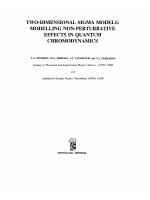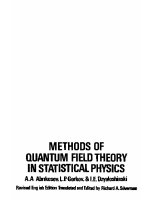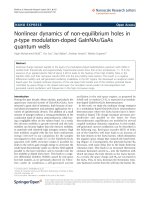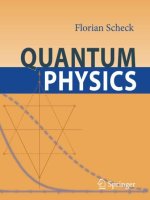Non hermitian hamiltonians in quantum physics
Bạn đang xem bản rút gọn của tài liệu. Xem và tải ngay bản đầy đủ của tài liệu tại đây (10.46 MB, 399 trang )
Springer Proceedings in Physics 184
Fabio Bagarello
Roberto Passante
Camillo Trapani Editors
Non-Hermitian
Hamiltonians
in Quantum
Physics
Selected Contributions from the 15th
International Conference on Non-Hermitian
Hamiltonians in Quantum Physics, Palermo,
Italy, 18–23 May 2015
Springer Proceedings in Physics
Volume 184
The series Springer Proceedings in Physics, founded in 1984, is devoted to timely
reports of state-of-the-art developments in physics and related sciences. Typically
based on material presented at conferences, workshops and similar scientific
meetings, volumes published in this series will constitute a comprehensive
up-to-date source of reference on a field or subfield of relevance in contemporary
physics. Proposals must include the following:
–
–
–
–
–
name, place and date of the scientific meeting
a link to the committees (local organization, international advisors etc.)
scientific description of the meeting
list of invited/plenary speakers
an estimate of the planned proceedings book parameters (number of pages/
articles, requested number of bulk copies, submission deadline).
More information about this series at />
Fabio Bagarello Roberto Passante
Camillo Trapani
•
Editors
Non-Hermitian Hamiltonians
in Quantum Physics
Selected Contributions from the 15th
International Conference on Non-Hermitian
Hamiltonians in Quantum Physics, Palermo,
Italy, 18–23 May 2015
123
Editors
Fabio Bagarello
Dipartimento di Energia
Università degli Studi di Palermo
Palermo
Italy
Camillo Trapani
Dipartimento di Matematica e Informatica
Università degli Studi di Palermo
Palermo
Italy
Roberto Passante
Dipartimento di Fisica e Chimica
Università degli Studi di Palermo
Palermo
Italy
ISSN 0930-8989
Springer Proceedings in Physics
ISBN 978-3-319-31354-2
DOI 10.1007/978-3-319-31356-6
ISSN 1867-4941
(electronic)
ISBN 978-3-319-31356-6
(eBook)
Library of Congress Control Number: 2016936644
© Springer International Publishing Switzerland 2016
This work is subject to copyright. All rights are reserved by the Publisher, whether the whole or part
of the material is concerned, specifically the rights of translation, reprinting, reuse of illustrations,
recitation, broadcasting, reproduction on microfilms or in any other physical way, and transmission
or information storage and retrieval, electronic adaptation, computer software, or by similar or dissimilar
methodology now known or hereafter developed.
The use of general descriptive names, registered names, trademarks, service marks, etc. in this
publication does not imply, even in the absence of a specific statement, that such names are exempt from
the relevant protective laws and regulations and therefore free for general use.
The publisher, the authors and the editors are safe to assume that the advice and information in this
book are believed to be true and accurate at the date of publication. Neither the publisher nor the
authors or the editors give a warranty, express or implied, with respect to the material contained herein or
for any errors or omissions that may have been made.
Printed on acid-free paper
This Springer imprint is published by Springer Nature
The registered company is Springer International Publishing AG Switzerland
Preface
This volume collects the selected contributions presented at or inspired by the
15th International Workshop on Pseuso-Hermitian Hamiltonians in Quantum
Physics (PHHQP15), held in Palermo, Italy, from May 18 to 23, 2015. This
workshop was the 15th in the series of international meetings that was started in
2003. These meetings were mainly attended by mathematicians and physicists
interested in the study of non-Hermitian operators and Hamiltonians, and in their
physical applications. About 80 mathematicians and physicists attended the 2015
Workshop in Palermo.
Even though mathematicians have deeply studied several aspects of the spectral
theory of operators since long time, the realization that non-Hermitian Hamiltonians
with PT symmetry may have a real spectrum has produced a growing interest in
theoretical physicists for this subject. From the mathematical side this renewed
perspective concerning operators with real spectrum has put on the stage new
methods aimed to find conditions for a non-self-adjoint operator to have a real
spectrum or it has led to revisiting (and, often, generalizing) older concepts (similarity, affinity, metric operators, etc.) as tools for studying this problem. From a
physical point of view the main outcome of this unconventional approach to
quantum mechanics has been the exploration of several new and interesting models.
Started as a pure mathematical problem, the subject of non-Hermitian
Hamiltonians with PT (parity-time) symmetry has rapidly grown in the past
years. It has also attracted much interest for its possible applications in physics,
since when it was shown that non-Hermitian Hamiltonians with PT symmetry can
have a real spectrum.
Nowadays, in fact, PT-symmetric non-Hermitian Hamiltonians have found
application in several areas of physics, for example in quantum optics, condensed
matter physics, non-equilibrium statistical physics, and quantum field theory, from
both the theoretical and experimental points of view. Typical important systems that
can be described by non-Hermitian Hamiltonians endowed with PT symmetry are
open systems with balanced gain–loss terms, where gain–loss mechanisms break
the Hermiticity while preserving the PT symmetry. Realistic examples are given by
v
vi
Preface
optical waveguides and periodic lattices with balanced absorption or amplification.
Other relevant aspects that have received great attention in recent times are, among
the others, PT-symmetry breaking phase transitions and formation of exceptional
points and spectral singularities.
The papers in this volume will cover several aspects of PT-symmetric
non-Hermitian Hamiltonians, investigating both mathematical and physical
aspects of the research topics mentioned above.
Palermo, Italy
Fabio Bagarello
Roberto Passante
Camillo Trapani
Acknowledgments
The organization of the 15th International Workshop on Pseuso-Hermitian
Hamiltonians in Quantum Physics was financially supported by
The President of the Assemblea Regionale Siciliana
The European Physical Society
The Gruppo Nazionale per l’ Analisi Matematica, la Probabilità e le loro
Applicazioni and the Gruppo Nazionale per la Fisica Matematica of the Istituto
Nazionale di Alta Matematica “F. Severi”
Università di Palermo
Dipartimento di Matematica e Informatica, Università di Palermo
Dipartimento di Energia, Ingegneria dell’Informazione e Modelli Matematici,
Università di Palermo
Dipartimento di Fisica e Chimica, Università di Palermo
Banca Nuova
and sponsored by the Società Italiana di Fisica.
We thank these Institutions for making possible this meeting. We also thank
speakers, contributors, chairpersons, and participants.
We also acknowledge the support of 3 PERIODICO s.n.c. Società di Ingegneria
and Bidditti—delicious Italian food.
Our special thanks go to the local organizing committee, Giorgia Bellomonte,
Francesco Gargano, Margherita Lattuca, Salvatore Spagnolo, Salvatore Triolo, and
Francesco Tschinke, for the great job they did.
Palermo, Italy
Fabio Bagarello
Roberto Passante
Camillo Trapani
vii
Contents
Real Discrete Spectrum of Complex PT-Symmetric Scattering
Potentials . . . . . . . . . . . . . . . . . . . . . . . . . . . . . . . . . . . . . . . . . . . . . .
Zafar Ahmed, Joseph Amal Nathan, Dhruv Sharma and Dona Ghosh
Geometrical and Asymptotical Properties of Non-Selfadjoint
Induction Equation with the Jump of the Velocity Field. Time
Evolution and Spatial Structure of the Magnetic Field . . . . . . . . . . . . .
Anna I. Allilueva and Andrei I. Shafarevich
PT Symmetric Classical and Quantum Cosmology . . . . . . . . . . . . . . . .
Alexander A. Andrianov, Chen Lan and Oleg O. Novikov
1
11
29
Operator (Quasi-)Similarity, Quasi-Hermitian Operators
and All that . . . . . . . . . . . . . . . . . . . . . . . . . . . . . . . . . . . . . . . . . . . .
Jean-Pierre Antoine and Camillo Trapani
45
Generalized Jaynes-Cummings Model with a Pseudo-Hermitian:
A Path Integral Approach. . . . . . . . . . . . . . . . . . . . . . . . . . . . . . . . . .
Mekki Aouachria
67
Exceptional Points in a Non-Hermitian Extension
of the Jaynes-Cummings Hamiltonian . . . . . . . . . . . . . . . . . . . . . . . . .
Fabio Bagarello, Francesco Gargano, Margherita Lattuca,
Roberto Passante, Lucia Rizzuto and Salvatore Spagnolo
DÀDeformed and SUSY-Deformed Graphene: First Results . . . . . . . . .
F. Bagarello and M. Gianfreda
83
97
Localised Nonlinear Modes in the PT-Symmetric Double-Delta Well
Gross-Pitaevskii Equation . . . . . . . . . . . . . . . . . . . . . . . . . . . . . . . . . . 123
I.V. Barashenkov and D.A. Zezyulin
Exactly Solvable Wadati Potentials in the PT-Symmetric
Gross-Pitaevskii Equation . . . . . . . . . . . . . . . . . . . . . . . . . . . . . . . . . . 143
I.V. Barashenkov, D.A. Zezyulin and V.V. Konotop
ix
x
Contents
The EMM and the Spectral Analysis of a Non Self-adjoint
Hamiltonian on an Infinite Dimensional Hilbert Space . . . . . . . . . . . . . 157
Natalia Bebiano and João da Providência
Bessel Sequences, Riesz-Like Bases and Operators in Triplets of
Hilbert Spaces . . . . . . . . . . . . . . . . . . . . . . . . . . . . . . . . . . . . . . . . . . 167
Giorgia Bellomonte
Geometric Aspects of Space-Time Reflection Symmetry in Quantum
Mechanics . . . . . . . . . . . . . . . . . . . . . . . . . . . . . . . . . . . . . . . . . . . . . 185
Carl M. Bender, Dorje C. Brody, Lane P. Hughston
and Bernhard K. Meister
Mathematical and Physical Meaning of the Crossings of Energy Levels
in PT-Symmetric Systems . . . . . . . . . . . . . . . . . . . . . . . . . . . . . . . . . 201
Denis I. Borisov and Miloslav Znojil
Non-unitary Evolution of Quantum Logics. . . . . . . . . . . . . . . . . . . . . . 219
Sebastian Fortin, Federico Holik and Leonardo Vanni
A Unifying E2-Quasi Exactly Solvable Model. . . . . . . . . . . . . . . . . . . . 235
Andreas Fring
Sublattice Signatures of Transitions in a PT-Symmetric Dimer
Lattice . . . . . . . . . . . . . . . . . . . . . . . . . . . . . . . . . . . . . . . . . . . . . . . . 249
Andrew K. Harter and Yogesh N. Joglekar
Physical Aspect of Exceptional Point in the Liouvillian Dynamics
for a Quantum Lorentz Gas . . . . . . . . . . . . . . . . . . . . . . . . . . . . . . . . 263
Kazunari Hashimoto, Kazuki Kanki, Satoshi Tanaka and Tomio Petrosky
Some Features of Exceptional Points . . . . . . . . . . . . . . . . . . . . . . . . . . 281
W.D. Heiss
Spontaneous Breakdown of a PT-Symmetry in the Liouvillian
Dynamics at a Non-Hermitian Degeneracy Point . . . . . . . . . . . . . . . . . 289
Kazuki Kanki, Kazunari Hashimoto, Tomio Petrosky and Satoshi Tanaka
Pseudo-Hermitian b-Ensembles with Complex Eigenvalues . . . . . . . . . . 305
Gabriel Marinello and Mauricio Porto Pato
Green’s Function of a General PT-Symmetric Non-Hermitian
Non-central Potential . . . . . . . . . . . . . . . . . . . . . . . . . . . . . . . . . . . . . 319
Brijesh Kumar Mourya and Bhabani Prasad Mandal
Non-Hermitian Quantum Annealing and Superradiance . . . . . . . . . . . . 329
Alexander I. Nesterov, Gennady P. Berman, Fermín Aceves de la Cruz
and Juan Carlos Beas Zepeda
Contents
xi
The Relationship Between Complex Quantum Hamiltonian Dynamics
and Krein Space Quantization. . . . . . . . . . . . . . . . . . . . . . . . . . . . . . . 345
Farrin Payandeh
Non-Hermitian PT -Symmetric Relativistic Quantum Theory in an
Intensive Magnetic Field . . . . . . . . . . . . . . . . . . . . . . . . . . . . . . . . . . . 357
V.N. Rodionov
Quasi-Hermitian Lattices with Imaginary Zero-Range
Interactions . . . . . . . . . . . . . . . . . . . . . . . . . . . . . . . . . . . . . . . . . . . . 371
Frantisek Ruzicka
Quantization of Big Bang in Crypto-Hermitian Heisenberg
Picture . . . . . . . . . . . . . . . . . . . . . . . . . . . . . . . . . . . . . . . . . . . . . . . . 383
Miloslav Znojil
Index . . . . . . . . . . . . . . . . . . . . . . . . . . . . . . . . . . . . . . . . . . . . . . . . . 401
Real Discrete Spectrum of Complex
PT-Symmetric Scattering Potentials
Zafar Ahmed, Joseph Amal Nathan, Dhruv Sharma and Dona Ghosh
Abstract We investigate the parametric evolution of the real discrete spectrum of
several complex PT symmetric scattering potentials of the type V (x) = −V1 Fe (x) +
i V2 Fo (x), V1 > 0, Fe (x) > 0 by varying V2 slowly. Here e, o stand for even and odd
parity and Fe,o (±∞) = 0. Unlike the case of Scarf II potential, we find a general
absence of the recently explored accidental (real to real) crossings of eigenvalues in
these scattering potentials. On the other hand, we find a general presence of coalescing of real pairs of eigenvalues at a finite number of exceptional points. After these
points, real discrete eigenvalues become complex conjugate pairs. We attribute such
coalescings of eigenvalues to the presence of a finite barrier (on the either side of
x = 0) which has been linked to a recent study of stokes phenomenon in the complex
PT-symmetric potentials.
The discovery [1] that the complex PT-symmetric Hamiltonians may have real discrete spectrum has given rise to PT-symmetric quantum mechanics. The coalescing of
real discrete eigenvalues at a parametric point and their transition to complex conjugate eigenvalues just after has been known earlier as a phenomenon of spontaneous
breaking of complex PT-symmetry. The exactly solvable complex PT-symmetric
Scarf II scattering potential
Z. Ahmed (B)
Nuclear Physics Division, Bhabha Atomic Research Centre,
Mumbai 400085, India
e-mail:
J.A. Nathan
Reactor Physics Design Division, Bhabha Atomic Research Centre,
Mumbai 400085, India
e-mail:
D. Sharma
National Institute of Technology, Rourkela 769008, India
e-mail:
D. Ghosh
Department of Mathematics, Jadavpur University, Kolkata 700032, India
e-mail:
© Springer International Publishing Switzerland 2016
F. Bagarello et al. (eds.), Non-Hermitian Hamiltonians in Quantum Physics,
Springer Proceedings in Physics 184, DOI 10.1007/978-3-319-31356-6_1
1
2
Z. Ahmed et al.
VS (x) = −V1 sech2 x + i V2 sech x tanh x, V1 , V2 ∈ R, V1 > 0,
(1)
has been well known to display spontaneous breaking of PT-symmetry when [2]
|V2 | = V2c = 1/4 + V1 (2m = 1 = 2 ). In the theory of exceptional points (EPs) of
non-Hermitian potentials [3], the value(s) of |V2 | = V2c are called EPs where the real
pairs of eigenvalues coalesce and just after they turn into complex conjugate pairs.
Exactly at these values the corresponding eigenstates become linearly dependent and
the Hamiltonian looses diagonalizability.
A recent study of the Stoke’s phenomenon of complex PT-symmetric potentials
claims [4] the occurrence of level-coalescing (they call it level-crossings) at infinite exceptional points in the potential V (x) = ig(x 3 − x). In√[4], this potential is
called “PT-symmetric double well” with “two wells at x = ±1/ 3”. Such potentials
as having this feature have been claimed to have infinite number level-coalescings.
However, in more simple terms this V (x) is such that its imaginary part has a finite
barrier on the either side of x = 0 according as g is positive or negative. In this
work, we show that evolution of several complex PT-symmetric scattering potentials whose imaginary part has a barrier on the either side of x = 0 have a finite
number of level-coalescings at the critical values |V2 | = V2c . It is important to recall
that the complex PT-symmetric potentials V (x) = x 2 + igx, V (x) = igx 3 , V (x) =
−V1 sech2 x + i V2 tanh x [5] do not entail coalescing of levels and exceptional points.
However, the interesting potential V (x) = x 4 + igx [6] does have them.
Recently, it has been found that the potential (1) has a very interesting property
wherein real discrete eigenvalues cross at special values V2∗ of |V2 |. This phenomenon
has been called accidental crossing [7] of real discrete eigenvalues in one-dimension.
As in one dimension, the degeneracy (two (distinct) linearly independent eigenstates
having coincident eigenvalue) cannot occur consequently the crossing levels have
linearly dependent eigenstates. This gives rise to loss of diagonalizability of the
Hamiltonian which in turn hampers the completeness of the spectrum of the potential.
Interestingly, the solvable regularized one-dimensional complex harmonic oscillator (RCHO) [8, 9] potential also had this feature of level-crossings however this
came up more clearly in two recent presentations [10, 11].
In the parlance of exceptional points of non-Hermitian Hamiltonians the abovementioned two types (real to real, real to complex) of crossings of levels may not be
distinguished. However the real to real crossing of eigenvalue appears to be so rare,
that so far only two potentials RCHO [8, 9] and Scarf II (1) have yielded it. Curiously,
the former is only binding (infinite spectrum) potential that does not allow scattering
whereas the latter allows both bound (finite spectrum) and scattering states.
So, with the motivation of studying level coalescings (and any possibility of
level-crossings), we propose to find the parametric evolution of the finite number
of eigenvalues for five models of complex PT-symmetric scattering potentials (see
Fig. 1) employing various methods.
We shall be solving the one-dimensional time-independent Schrödinger equation
d 2 ψ(x) 2μ
+ 2 [E − V (x)]ψ(x) = 0
dx2
(2)
Real Discrete Spectrum of Complex …
(a)
3
(b)
Fig. 1 Schematic depiction of the Complex PT-symmetric scattering potentials, real part (thick
line), imaginary part (thin line). a Represents the rectangular well V R (x) (4) and b represents VS (x)
(1), VG (x) (5), VF (x) (6), VH (x) (7) and VW C (x) (14)
for five models of one-dimensional complex PT-symmetric scattering potentials.
These potentials (see Fig. 1) essentially vanish at x = ±∞ and their real part constitutes a well which support only a finite numbers of real discrete eigenvalues. Their
imaginary parts are the corresponding anti-symmetric profile. These potential wells
are piece-wise constant rectangular, Gaussian, −(1 + x 4 )−1 , −sech x and WignerCoulomb profiles.
We would like to outline our method of finding real discrete eigenvalues
√by numerical integration of the Schrödinger equation (2). Let us define k = −2μE/ .
We take the general solution of (2) as ψ(x < −L) = Cekx , ψ(−L < x < L) =
Au(x) + Bv(x), ψ(x > L) = De−kx . Here u(x) and v(x) are linearly independent
solutions of (2), their initial values as u(0) = 1, u (0) = 0 and v(0) = 0, v (0) = 1
to start the integration to both left and right side up to −L and +L, respectively.
L is sufficiently large distance to be chosen. We match these piece-wise solutions
and their first derivatives at x = −L , 0, L. Finally, we eliminate A, B, C, D in the
resulting equations to obtain the eigenvalue formula
ku(−L) − u (−L)
ku(L) + u (L)
=
kv(L) + v (L)
kv(−L) − v (−L)
(3)
to find the eigenvalues.
We choose the distance L such that the final results (eigenvalues) have the desired
accuracy. For all the calculations here we use 2μ = 1 = 2 . Using (3), we fix a
value of V1 so that there are at least 6 real discrete eigenvalues for the real potential
well (V2 = 0) by varying E = −V1 to E = 0. Next, V2 is proposed to vary slowly
till we get real pairs of eigenvalue curves which coalesce. We call these special
values of V2 as V2c which are known as exceptional points (EPs) of non-Hermitian
potential. Nonetheless, we are interested to see whether or not there will be crossings
of real discrete eigenvalues from real to real when we vary V2 . The eigenvalues of
complex PT-symmetric potentials (4, 5, 6, 7, 14) considered here in the sequel satisfy
E n (−V2 ) = E n (V2 ), we therefore evaluate E n (V2 ) only for V2 > 0.
First, to confirm our numerical method, we take up the well known rectangular
complex PT-symmetric profile [12] of width 2a.
4
Z. Ahmed et al.
0
– 10
– 20
– 30
– 40
0
2
4
6
8
Fig. 2 The parametric evolution of real discrete spectrum, E n (V2 ), for rectangular potential with
V1 = 40 and a = 2, notice that there are no level-crossings, but the eigenvalue pairs do coalesce at
the exceptional points |V2 | = 0.96, 2.75, 4.88, 7.33. The solid line is due to numerical integration
using (3) and the dots are due to the exact analytic method using (9)
V R (x) = −V1 Θ1 (x) − i V2 Θ2 (x), Θ1 (x) =
⎧
|x| ≥ a
⎨ 0,
1, |x| ≤ a
, Θ2 (x) = −1, −a < x < 0 (4)
0, |x| > a
⎩
1,
0≤x
which is also solvable analytically (see (9)). The potential (4) being of finite support we take L = a = 2. In Fig. 1, the solid lines are due to numerical integration
method using (3). No crossing (real to real) of eigenvalues is observed but eigenvalues coalesce at |V2 | = V2c = 0.96, 2.75, 4.88, 7.33. Next, we find the evolution of
eigenvalues of Gaussian model for V1 = 50
VG (x) = V1 e−x + i V2 xe−x , V1 , V2 ∈ R, V1 > 0.
2
2
(5)
By this method a distance of L = 10–12 has been found sufficient for the convergence
of eigenvalues. In Fig. 3, the solid lines represent the result due to (3). The exceptional
points for this potential (5) are |V2 | = V2c = 43.26, 55.55, 63.70 and the crossing of
levels is not found. In Fig. 4, the parametric evolution of the spectrum of
VF (x) =
−V1
i V2 x
+
, V1 , V2 ∈ R, V1 > 0
4
1+x
1 + x4
(6)
is presented. The pairs of eigenvalues are well separated from each other and the
levels do not cross. They do coalesce at |V2 | = V2c = 19.39, 38, 87, 46.35, we have
fixed V1 = 50. So, for |V2 | < 19.39 all the discrete eigenvalues are real and PTsymmetry is un-broken. After this critical value, the initial discrete eigenvalues start
disappearing. Let us now consider sech-hyperbolic potential
VH = −V1 sech x + i V2 sech xtanh x, V1 , V2 ∈ R, V1 > 0
(7)
Real Discrete Spectrum of Complex …
5
whose real part is sech x unlike the Scarf II potential (1). See in Fig. 5, the eigenvalue
pairs are well separated without crossing each other, they coalesce at |V2 | = V2c =
25.37, 31.15, 34.92, 37.35.
In the following, we find eigenvalues of (4) alternatively by the exact and analytic
method which will also confirm the results in Fig. 2. We insert this potential in the
Schrödinger equation (2). Assuming 2m = 1 = , we define
p = a E + V1 − i V2 , q = a E + V1 + i V2 , r = ak, k =
√
−E.
(8)
The solution of (1) for this potential can be written as ψ(x < −a) = Fekx , ψ(−a <
x < 0) = C sin q x + D cos q x, ψ(0 < x < a) = A sin px + B cos px, ψ(x > a) =
Ge−kx . By matching these solutions and their first derivative at x = −a, 0, a, we
eliminate A, B, C, D, F, G to get the eliminant as
2 pqr cos p cos q + p(r 2 − q 2 ) cos p sin q + q(r 2 − p 2 ) sin p cos q
− r ( p 2 + q 2 ) sin p sin q = 0,
(9)
which serves as an analytic eigenvalue equation to be solved by varying E from
−V1 to 0. By fixing V1 = 20, and a = 2, we obtain the parametric evolution of the
spectrum of (4). These results are shown by dots in Fig. 2. See an excellent agreement
between the two.
Below, we propose to find the eigenvalues of the Gaussian potential (5) potential alternatively by the diagonalization of H = p 2 /(2μ) + VG (x) in the harmonic
2
oscillator (HO) basis. For HO basis |n , we know that H0 = − ddx 2 + x 2 , H |n =
2
(2n + 1)|n , where 2μ = 1 = , ω = 2. Using the well known a, a † operators,
we know that
√
√
(n − 1)n
(n + 1)(n + 2)
(2n + 1)
δm,n−2 +
δm,n −
δm,n+2 .
m| p 2 |n = −
2
2
2
(10)
More interestingly the following required matrix elements can be found analytically
with help of available but rare integrals [13]
m|e−x |n = cos[(m − n)π/2]
2
and
m|xe−x |n =
2
Γ [(m + n + 1)/2]
,
√
2π m!n!
Γ [(m
√ (m − n)
√ + n)/2] ,
2 2 sin[(m − n)π/2]
2πm!n!
0,
if, m + n = odd
otherwise.
(11)
(12)
Using (10, 11, 12), we write the matrix elements h m,n = m|H |n to get the
eigenvalues as
(13)
det |h m,n − E δm,n | = 0.
6
Z. Ahmed et al.
Fig. 3 The same as in Fig. 2,
for VG (x) (5), when
V1 = 50. The solid line
is due to (3) and dots
are due to (13). The
exceptional values are
|V2 | = 43.26, 55.55, 63.70
0
– 10
– 20
– 30
– 40
– 50
Fig. 4 The same as in Fig. 2,
for VF (x) (6). These results
are due to (3) and the
exceptional point are
|V2 | = 19.39, 38, 87, 46.35
and V1 = 50
0
10
20
30
40
50
60
0
– 10
– 20
– 30
– 40
– 50
0
10
20
30
40
50
In Fig. 3, see the excellent agreement between solid lines (using (3) and dots (obtained
by diagonalization using (13)).
Our last model to be discussed is the Wigner-Coulomb type complex PTsymmetric scattering potential expressed as
VW C (x) =
−V1
i V2 x
+
, V1 , V2 ∈ R, V1 > 0.
2
1+x
1 + x2
(14)
The Schrödinger equation for this potential is known to be unamenable. A special
case (V1 = V2 ) of this potential is VW C (x) = xi V−2i which is a complex regularized
PT-symmetric potential and on the real line x ∈ (−∞, ∞) its discrete spectrum is
null. This may well be understood by realizing that for any real value of E it gives
rise to only one classical turning point (for bound states there should at least be two
turning points). This special case also serves to a priori indicate that V2c < V1 . The
aforementioned special case of complex Coulomb potential has been treated [14, 15]
on a special complex trajectory to find a real discrete spectrum.
Real Discrete Spectrum of Complex …
7
2
p
In order to solve the eigenvalue equation H ψ = Eψ, where H = [ 2μ
+ V (x)].
Here we use a special method [16, 17] wherein we find the roots of E by solving the
determinantal equation
det | m|(1 + x 2 )H − E x 2 )|n − Eδm,n | = 0,
(15)
where |n are the well known harmonic oscillator eigenstates. The motive behind
choosing this method [16, 17] is two-fold. The matrix elements like m|(1 + x 2 )−1 |n
cannot be found analytically. As the determinant becomes larger and larger, the
analytic matrix elements are more desirable. Secondly, the imaginary part of this
potential (1) like the Coulomb potential varies as ∼1/|x|, asymptotically. This insufficiently rapid asymptotic fall off of the coulomb potential brings in the typical
problems in the integration of the Schrödinger for asymptotic values. We again take
2μ = 1 = 2 , ω = 2 the eigenvalue equation (2) can be expressed as
det |Hm,n (E)| = 0
Hm,n = m| p |n + m|x p |n − (E + V1 ) m|n + i V2 m|x|n − E m|x 2 |n .
(16)
2
2 2
m|x|n =
n
δm,n−1 +
2
(n + 1)
δm,n+1
2
(17)
√
√
(n − 1)n
(n + 1)(n + 2)
(2n + 1)
m|x |n =
δm,n−2 +
δm,n +
δm,n+2 (18)
2
2
2
2
m|x 2 p 2 |n = −
(n − 3)(n − 2)(n − 1)n δm,n−4 /4 +
+ (2n + 2n − 1) δm,n −
2
−
n(n − 1) δm,n−2
(n + 1)(n + 2) δm,n+2 /4
(n + 1)(n + 2)(n + 3)(n + 4) δm,n+2 /4
−
(n + 1)(n + 2)(n + 3)(n + 4) δm,n+4 /4.
(19)
Curiously, the parametric evolution of eigenvalues obtained for this potential is qualitatively different from the other ones: VR (x), VG (x), VF (x), VH (x) discussed above.
See in Fig. 6, the initial eigenvalue curves are longer which go on becoming shorter
for higher eigenvalues. Once again there are no crossings of eigenvalues, but eigenvalues coalesce at |V2 | = 19.73, 10.87, 5.53, 2.75 (Fig. 5).
Most importantly, for all the scattering potentials considered here, we find that the
change of the depth parameter V1 changes the number of discrete eigenvalues and the
subsequent values of exceptional points where energy levels coalesce and just after
they become complex conjugate pairs. Based on our calculations, we can claim that
by changing V1 we do not detect any real to real crossings of discrete eigenvalues as
8
Fig. 5 The same as in Fig. 2,
for VH (x) (7), V1 = 50. The
exceptional points are |V2 | =
25.37, 31.15, 34.92, 37.35
Z. Ahmed et al.
0
– 10
– 20
– 30
– 40
– 50
Fig. 6 The same as Fig. 2,
for the Wigner-Coulomb
potential (14),
V1 = 20, a = 2. The
exceptional points are |V2 | =
19.73, 10.87, 5.53, 2.74.
These results are due to the
special method [12, 13] of
diagonalization (16)
0
10
20
30
40
0
5
10
15
20
0
–5
– 10
– 15
it happens [7] in the case of complex PT-symmetric Scarf II scattering potential of
the similar shape as in Fig. 1a, b.
To conclude, in this paper we have found parametric evolution of eigenvalues for
five complex PT-symmetric scattering potentials employing different methods. Such
works are instructive and desirable especially when complex PT-symmetry makes
way in to textbooks of quantum mechanics. Unlike the Scarf II, these scattering
potentials do not give rise to the real to real crossing of discrete eigenvalues. In
this regard, the present work also attracts the attention on Scarf II (and also the
RCHO) as two highly exceptional cases of accidental crossings of eigenvalues. The
reason behind their specialty needs to be investigated. However, the PT-symmetric
scattering potentials discussed here do display a general coalescing of eigenvalues at
a finite number exceptional points, we attribute this phenomenon to the occurrence
of a finite barrier either side of x = 0. This may be sufficient but not a necessary
condition on a potential for the occurrence of level-coalescing. Further confirmations
and investigations are welcome in this regard.
Acknowledgments Dona Ghosh wishes to thank Prof. Subenoy Chakraborty for his support and
interest in this work.
Real Discrete Spectrum of Complex …
9
References
1. C.M. Bender, S. Boettcher, Phys. Rev. Lett. 80, 5243 (1998); C.M. Bender. Rep. Prog. Phys.
70, 947 (2007)
2. Z. Ahmed, Phys. Lett. A 282, 343 (2001); 287, 295 (2001)
3. T. Kato, Perturbation Theory of Linear Operators (Springer, N.Y. Springer, 1980)
4. R. Giachetti and V. Grecchi, Level crossings in a PT-symmetric double well. arXiv:1506:0167
[math-ph]
5. G. Levai, E. Magyari, J. Phys. A: Mat. Theor. 42, 195302 (2009)
6. C.M. Bender, M.V. Berry, O.N. Meisinger, V.M. Savage, M. Simsek, J. Phys. A : Math. Gen.
34, L31 (2001)
7. Z. Ahmed. J.A. Nathan, D. Ghosh, G. Parkar, Phys. Lett. A 327, 2424 (2015)
8. M. Znojil, Phys. Lett. A 259, 220 (1999)
9. B. Bagchi, C. Quesne, M. Znojil, Mod. Phys, Lett. A 16, 2047 (2001)
10. M. Znojil, arXiv:1303:4876; D.I. Borisov, Acta Polytech. 54, 93 (2014). arXiv:1401:6324
11. F. Bagarello, J.P. Gazeau, F.H. Szafraniec, M. Znojil, Non-Selfadjoint Operators in Quantum
Physics: Mathematical Aspects, Fig. on p.22 (John Wiley & Sons, Inc., 2015). ISBN 978-1118-85528-7
12. M. Znojil, Phys. Lett. A 285, 7 (2001); Z. Ahmed, Phys. Lett. A 324, 154 (2004); Z. Ahmed,
J. Phys. A: Math. Teor. 47, 385303 (2014)
13. A. Erdelyi, W. Magnus, F. Oberhettinger, F.G. Tricomi, Table of Intregral Transforms, vol. (II)
(McGraw-Hill, New York, 1954), pp. 289–290
14. M. Znojil, G. Levai, Phys. lett. A 271, 327 (2000)
15. G. Levai, Pramana J. Phys. 6(73), 329 (2009)
16. K.V. Bhagwat, J. Phys. A Math. Gen. 14, 377 (1981)
17. S.J. Hamerling, Latent Roots and Latent Vectors (Adam Hilgr, London, 1954), pp. 62–70
Geometrical and Asymptotical Properties
of Non-Selfadjoint Induction Equation
with the Jump of the Velocity Field. Time
Evolution and Spatial Structure
of the Magnetic Field
Anna I. Allilueva and Andrei I. Shafarevich
Abstract We study asymptotic solutions of the nonlinear system of MagnetoHydrodynamics. The solutions are assumed to jump rapidly near certain 2D-surface in
3D-space. We study the time behavior of the solution. In particular, we derive free
boundary problem for the limit values of the magnetic field and the velocity field
of the fluid. This problem governs also the evolution of the surface of the jump. We
derive equations on the moving surface, describing the evolution of the field profile.
In particular, we prove that the effect of the instantaneous growth of the magnetic field
takes place only for degenerate asymptotic modes. This effect is deeply connected
with non-Hermitian structure of the linearized induction operator.
1 Introduction
Equations of Magnetohydrodynamics (the MHD equations) describe the motion of
the magnetic field in a conducting fluid. This nonlinear system of PDE’s consists
of the Navier-Stokes equations for the velocity field of the fluid and the Maxwell
A.I. Allilueva (B) · A.I. Shafarevich
Ishlinsky Institute for Problems in Mechanics RAS, Prospekt Vernadskogo,
101-1, Moscow 119526, Russia
e-mail:
A.I. Allilueva · A.I. Shafarevich
National Research Centre “Kurchatov Institute”, 1, Akademika Kurchatova Pl,
Moscow 123182, Russia
A.I. Allilueva
Moscow Institute of Physics and Technology, Institutskaya, 9 Dolgoprundny,
141700 Moscow Region, Russia
A.I. Shafarevich
“M.V. Lomonosov” Moscow State University, Leninskie Gory, 1,
119992 Moscow, Russia
e-mail:
© Springer International Publishing Switzerland 2016
F. Bagarello et al. (eds.), Non-Hermitian Hamiltonians in Quantum Physics,
Springer Proceedings in Physics 184, DOI 10.1007/978-3-319-31356-6_2
11
12
A.I. Allilueva and A.I. Shafarevich
equations for the magnetic field. The equations are coupled by the term, describing the
Lorenz force. The MHD equations describe, in particular, evolution of the magnetic
fields of planets, stars and galaxies. Usually the viscosity and the resistance of the
fluid are small enough and one can study the asymptotic solutions of the system
with respect to the corresponding small parameter. This problem was studied in a
lot of papers; note that in linear approximation the structure of the asymptotics is
the subject of the famous dynamo theory (see, e.g. [1–12]). The main mathematical
problem (which is still open) is to prove the existence of exponentially growing
solutions.
The alternative effect was studied in [13, 14] (in linear approximation also).
Namely, we described the instantaneous growth of the magnetic field, induced by the
jump of the velocity field of the fluid. In another words, we studied the asymptotics
of the solution for the Cauchy problem for linear induction equation with rapidly
varying velocity field. We assumed that this field had a rapid jump in a small vicinity
of the fixed 2D surface. We proved that the solution grows rapidly with respect to
the corresponding small parameter, and has a delta-type singularity near the surface
of the jump. This effect is a result of the non-Hermitian structure of the linearized
induction operator—in certain sense the operator of the problem is close to the Jordan
block.
Here we study the analogous problem for the complete nonlinear system. We
describe the asymptotic structure of the solution with a rapid jump near 2D-surface.
Now the surface is not fixed—it moves in time together with the solution. We obtain
the special free boundary problem which governs the movement of the surface. We
also study the possibility of the instantaneous growth of the magnetic field. It appears
that the growth is possible only in the case of so called degenerate Alfwen modes;
the latter appear if the main term of the magnetic field is tangent to the surface of the
jump.
2 Statement of the Problem
2.1 The Cauchy Problem with the Jump of Initial Fields
We denote by B(x, t) and V (x, t) the magnetic and velocity fields in a conducting
fluid (B, V are time-dependent vector fields in R 3 ). This pair of vector functions
satisfy the following nonlinear MHD system
∂B
+ (V, ∇)B − (B, ∇)V = ε2 μ B
∂t
∂V
+ (V, ∇)V − (B, ∇)B + ∇ P = ε2 ν V
∂t
(∇, V ) = 0, (∇, B) = 0.
(1)
(2)
(3)
Geometrical and Asymptotical Properties of Non-Selfadjoint Induction Equation …
13
Here P(x, t) is a scalar function, which can be expressed in terms of B and the
pressure of the fluid, ν μ are positive numbers, characterizing hydrodynamic and
magnet viscosities, ε → 0 is a small parameter.
Let us consider for the system (1) initial data of the form
B|t=0 = B 0
Φ0 (x)
, x, ε , V |t=0 = V 0
ε
Φ0 (x)
, x, ε ,
ε
(4)
where Φ0 (x) is a smooth scalar function, divergence free vector fields B 0 (y, x, ε),
V 0 (y, x, ε) depend smoothly on all arguments and tend to limits B 0,± (x, ε), V 0,±
(x, ε) as y → ±∞ faster then any power of y. We assume that the equation Φ0 (x) =
0 defines a smooth compact surface M0 ⊂ R 3 and Φ(x, t) < 0 inside the domain,
bounded by the surface. Without the loss of generality one can assume also that in
the vicinity of the surface |Φ0 | equals the distance from M0 in the normal direction;
in particular, in this vicinity |∇Φ0 | = 1.
Remark 1 Vector fields of this type define “smoothened” discontinuities—as ε → 0
they tend to the discontinuous functions with the jump on the surface M0 . The
corresponding weak limits have the form
B 0 = B 0,+ (x, 0) + θ M0 (B 0,− (x, 0) − B 0,+ (x, 0)),
V 0 = V 0,+ (x, 0) + θ M0 (V 0,− (x, 0) − V 0,+ (x, 0)),
where θ M0 is the Heaviside function on M0 .
In the next sections we describe the asymptotic solutions to the Cauchy problem (1)–(4) under some additional assumptions concerning the initial fields. These
assumptions define separate nonlinear modes.
2.2 Degenerate and Nondegenerate Alfwen Modes
The structure of the asymptotic solution to the Cauchy problem (1)–(4) depends
essentially of the presence of the points of the initial surface, in which B 0 (y, x, 0) is
tangent to M0 . We will study two limit cases: in the first case there are no such points
(nondegenerate modes) while in the second one B 0 is tangent to M0 everywhere
(degenerate mode). We do not study the problem of nonlinear interaction of modes;
note that even in linear approximation this problem is highly nontrivial (for WKBtype solutions this problem was studied recently in [15]). Note that it is easy to prove
that, according to the equations governing the motion of the surface, the points of
tangency can not appear or disappear—the absence or presence of these points is a
property of the initial data.
If there is no tangency, on can extract the single nondegenerate mode with the
help of additional conditions on the initial fields; these conditions (which are well
14
A.I. Allilueva and A.I. Shafarevich
known in the MHD theory) state that the fields ∂ V (y,x,0)
and ∂ B (y,x,0)
must coincide
∂y
∂y
up to a sign. To be definite, we chose the sign “+”; so for nondegenerate mode we
assume additionally that
0
0
∂ V 0 (y, x, 0)
∂ B 0 (y, x, 0)
=
.
∂y
∂y
(5)
For the degenerate mode we assume that B is tangent to M:
(B 0 (y, x, 0), ∇Φ0 ))| M0 = 0.
(6)
Our goal is the description of the formal asymptotic solution as ε → 0 of the
Cauchy problem (1–4) under additional conditions (5) or (6).
3 Formulation of the Results. Nondegenerate Modes
Here we describe the structure of asymptotic solution corresponding to nondegenerate mode. The main term of asymptotics is defined by the free boundary problem for
the limit fields as y → ±∞ and by the equation on the moving surface, describing
the profile of the rapidly varying field. Surprisingly, the latter equation appears to be
linear.
3.1 Free Boundary Problem for Limit Fields
Let the conditions (5) are fulfilled; we denote by u 0 (y, x), w0 (x) the main terms of
the sum and the difference of the velocity field and the magnetic field in the initial
instant of time:
u 0 = V 0 (y, x, 0) + B 0 (y, x, 0), w0 = V 0 (y, x, 0) − B 0 (y, x, 0).
±
Let u ±
0 , w0 be the limits of u 0 , w0 as y → ±∞. Let us consider the following free
boundary problem: for a finite time interval t ∈ [0, T ] we seek for a smooth compact
surface Mt ∈ R 3 and for smooth vector fields u ± (x, t), w ± (x, t) and scalar functions
P0± (x, t), defined in the internal (Dt− ) and external (Dt+ ) domains and satisfying for
x ∈ Dt± the following equations
∂u ±
∂t
∂w ±
∂t
+ (w ± , ∇)u ± + ∇ P0± = 0,
±
+ (u , ∇)w
±
±
+ ∇ P0±
±
= 0,
(∇, u ) = (∇, w ) = 0.
(7)
(8)
(9)
Geometrical and Asymptotical Properties of Non-Selfadjoint Induction Equation …
15
We put also the conditions on the surface
[w] = 0, [P0 ] = 0, [u n ] = 0, −
∂Φ
= wn , x ∈ M t
∂t
(10)
and the initial conditions
±
±
±
Φ|t=0 = Φ0 (x), u ± |t=0 = u ±
0 , w |t=0 = w0 , x ∈ D0 .
(11)
Here Φ(x, t) denote the distance (with the appropriate sign) from the surface Mt
in the normal direction, u n = (u, ∇Φ)| Mt , wn = (w, ∇Φ)| Mt , symbol [ f ] denotes
the jump of the function f :
[ f ] = f + | Mt − f − | Mt .
Remark 2 The surface Mt is defined by the equation Φ(x, t) = 0; the boundary
= wn means that the surface moves along the trajectories of the
condition − ∂Φ
∂t
vector field w.
3.2 Linear Equations on the Moving Surface,
Describing the Rapidly Varying Part of the Solution
Let Φ, u ± , w ± , P0± be the smooth solution of the free boundary problem, formulated
above. Let us consider 3D surface Ω ⊂ R 4 , defined by the equation Φ(x, t) = 0
(trace of the moving surface Mt ). Note that the field ∂/∂t, generally speaking, is not
tangent to this surface; we denote by ∂t the projection of ∂/∂t to the tangent plane to
Ω. We denote by wˆ the projection of the field w| Mt to the tangent plane to Mt and
let B be the second fundamental form operator (that is the operator in the tangent
plane with the eigenvalues equal to the principle curvatures and eigenvectors equal
to the principle directions). The rapidly varying part of the main term of asymptotic
solution—vector field h on the surface Mt —satisfies the Cauchy problem
L∂t h + αy
∂ 2h
∂h
1
+ ∇ˆ wˆ h − wn Bh = (μ + ν) 2 ,
∂y
2
∂y
h|t=0 = Π (u 0 − u −
0 )| M0 .
(12)
(13)
Here ∇ˆ denotes the covariant derivative on the surface Mt , L denotes Lie derivative on Ω, Π is the projection to the tangent plane to Mt ,
α=
∂
|M
∂Φ t
∂Φ
+ (w, ∇Φ) .
∂t









